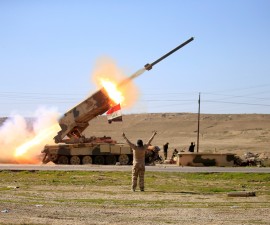(单词翻译:单击)
HARI SREENIVASAN, PBS NEWSHOUR WEEKEND ANCHOR: It is now the fourth month that the Iraqi army has been working to drive ISIS out of Mosul, the country's second largest city. Iraq's air force has carried out its first-ever strikes on ISIS positions inside in neighboring Syria.
"Wall Street Journal" reporter Ben Kesling is covering the conflict and joins me now by Skype from Irbil.
Ben, we're catching up with you partly because oftentimes the news about the fight in Iraq gets buried by the things that are happening in Washington here. Give us a quick status update. What's been happening the last few weeks?
BEN KESLING, THE WALL STREET JOURNAL: Well, the most important thing is over the weekend, the Iraqi ground forces launched an offensive on the west side of Mosul. So, Mosul is divided down the middle by the Tigris River. The east side was taken from Islamic State by Iraqi forces in a campaign that began October. Now that campaign has resumed on the other side of the Tigris River, on the west side of Mosul.
West side of Mosul is filled with old neighborhoods that are — have twisted, very dense, it's going to be very — it's supposed to be very difficult for the Iraqi military and they are facing that now.
But over the weekend that — weekend that offensive was launched. They've — in the past few days, have pushed through taken the airport in the city and then started moving north into some of these dense neighborhoods.
SREENIVASAN: One of your recent stories started talking about the presence of drones. We're not talking about the predator-type drones, but that ISIS is using the drones that we might see in a mall in the U.S., those little quad-copter ones.

KESLING: That's right. Yes, the Islamic State overtime has sort of modified their drone use — drone technology. Months ago, when you got to the battlefield you would see some of these drones that would be shot town, and they kind of looked like crude model airplanes in some cases.
But over time, the Islamic State has learned that by using quad-copter type drones, with four rotors, the kind that you can go down to the mall and pick up, they've retrofitted these things with some sort of release mechanism and now, they are flying over Iraqi positions, both Iraqi military and civilians in some cases and dropping conventional grenades which detonate on impact, which has — the Iraqi military and U.S. coalition, which is supporting the Iraqi military push have said that this isn't going to prevent the retaking of Mosul but it is causing death. It is causing injuries and it's worrisome for the Iraqi ground troops and for civilians in the city who have to — who have to deal with this threat.
SREENIVASAN: Tell us a little bit about that. How many civilians are still stuck in that part of the city?
KESLING: Well, it's unclear. There is no great estimate on the number of civilians. But it's likely that there are — that there are still hundreds of thousands of people. Just over the past couple of days, there have been more than 3,000 people who have pushed out of the city, 3,000 civilians. That's according to a new count that came out on Sunday from Iraqi officials. And the U.N. and other aid organizations are expecting to see a number of — a number of more civilians that are being pushed out as displaced persons.
SREENIVASAN: All right. Ben Kesling of "The Wall Street Journal", joining us via Skype today from Irbil — thanks so much.
KESLING: Thank you.


